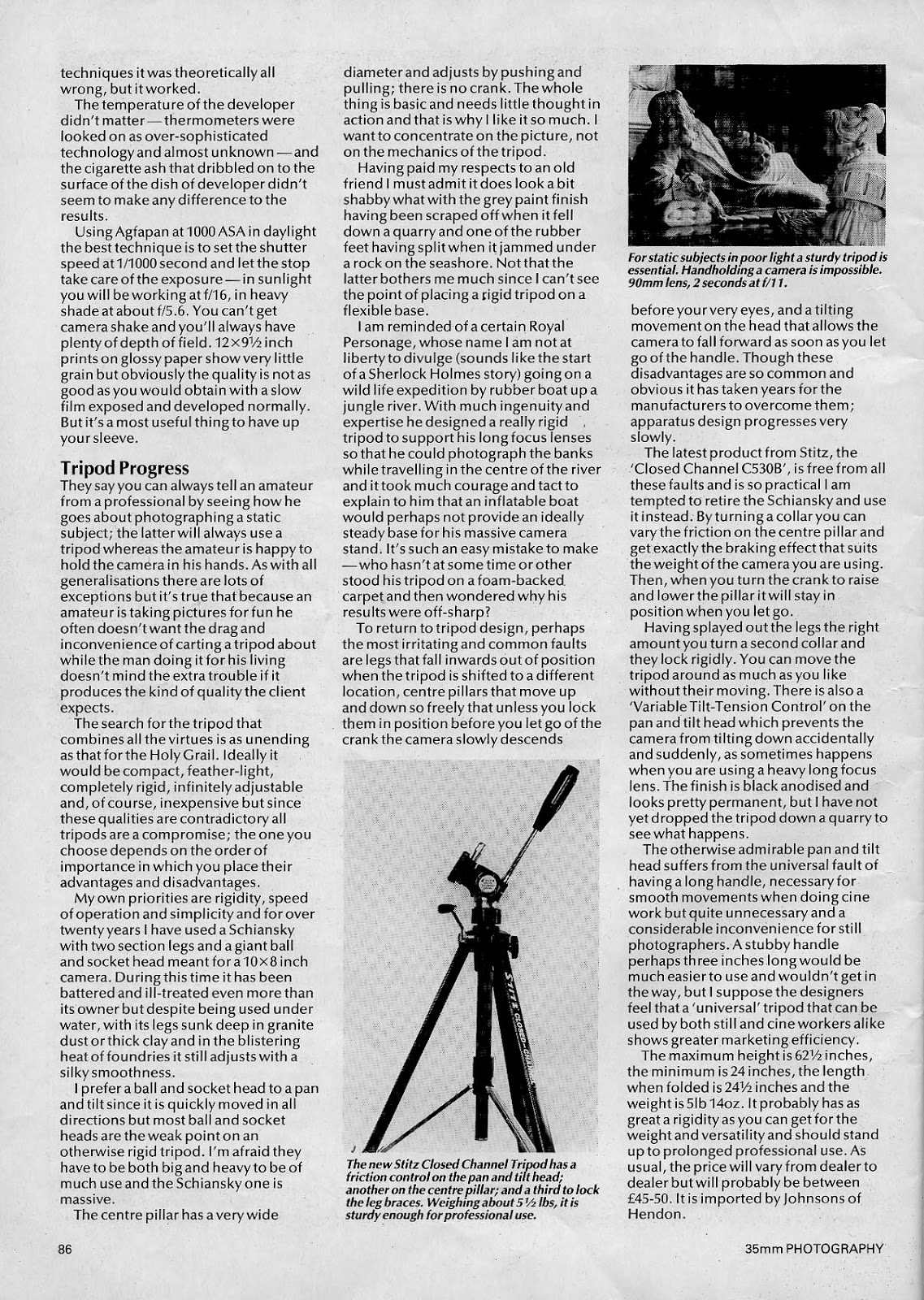Here's another great column from Kevin. He was smitten by three things in this article: Johnsons' Unitol developer, Agfapan 400 and the Minolta XE-1. Bearing in mind that he had a close working relationship with Johnsons he, nevertheless, seemed genuinely impressed by this no longer available brew.
I don't think the formula has ever been released although I'm open to correction on that point. I know that the company that succeeded Johnsons wouldn't release the formula for Definol to Barry Thornton even though they had no plans ever to make it again.
I can be a bit more confident about the XE-1 as I have one (it's actually the identical XE-7 made for the US market) and it's a very fine instrument. It has the lightest, smoothest film advance of any SLR I've handled. It's built like a pocket battleship and weighs about the same. The only slight negative is the viewfinder which is good but not as bright as some others.
I've got it with a PG 50mm f1.4 MC Rokkor which is as fine a standard lens as you could wish for. The Leica R3, which is essentially the same camera - there was a lot of collaboration between the two companies at this time - has a brighter screen and is probably the one to have if you can afford the dearer lenses. An R3 with a 35mm Summicron would be quite a beast.
And so onto Kevin...
35mm Photography Magazine
November, 1983









Bruce - thanks for posting this. I love reading these old columns. They are so much more interesting than what you get in photo mags these days. I hope you've got many more of them! Are you going to put them altogether in the sidebar like you did with Omar's posts?
ReplyDeleteNow this is a very interesting article for me, and just at the right time. You might remember my post titled "In Search of Speed" where my thinking was that pushing is not very rewarding. However, recently I've been doing some funny tests with overdevelopment and I might have stumbled on some surprise. My findings are premature at this stage but I'll still venture to say that Tmax400 exposed at 1600 and developed in an MQ developer for twice the normal time might be an avenue worth exploring. I still need to test it under differing lighting conditions so please don't take my word for it.
ReplyDeleteThanks for posting this article!
Sounds interesting, Omar. I'm looking forward to your conclusion.
ReplyDeleteEric, bringing all the Kevin posts together is a good idea. Thanks for that!
ReplyDeleteThe problem with this article is that there aren't anymore Agfa 400 and I don't know about t that kind of developer. So this produce to me some anxiety to explore the goods of 1000 ASA at equal 400 quality more or less.
ReplyDeleteTalking about old good disappeared developers for pushing there is the mythical Harvey 777 that used Eugene Smith and that is almost imposible to get in this times. It worked in a very strange way, you need to pre use it with minor things, the soup worked better after you developed some rolls.
I still have some tin boxes with english Promicrol that my father purchase in the 70's or something. I remember it very good to push processing.
Microphen, that is mentioned in the article, is a very good developer to push but lacks acutance. The pattern of the grain is very bad for my taste. I prefer use it diluted 1:1 to make the soup less solvent cause the diluted sulfite. This way I appreciate Microphen a lot more.
I did some work for another photojournalist and he asked that I develop his 320 Tri X PRO pushing two stops with Xtol 1:1. The results where very very good. Pushing two stops you always will lost shadow details and some highlight blocking but this mix worked pretty well and added no much grain.
The other not common to push but was used that way in the past by Life laboratories employees, was the D-23. But I can't find anymore metol here in Argentina. I had mixed emotions with this developer but I think is more because my metol maybe is exhausted, very old. The good thing with the D-23 formula is the simplicity, the good detail and grain and more important for push processing, it works very gently with the highlights. So, if you agitate gently you can get very nice push processed negatives. I wonder how will works this developer for push processing the new TMY-2. I would love to try that. But no metol by now.